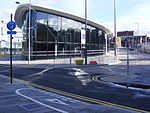Rochdale Society of Equitable Pioneers
1844 establishments in EnglandAccuracy disputes from September 2022All accuracy disputesBritish cooperative organizersCompanies based in Rochdale ... and 7 more
Consumers' co-operatives of the United KingdomFood cooperatives in the United KingdomFormer co-operatives of the United KingdomHistory of RochdaleRetail companies disestablished in 1991Retail companies established in 1844The Co-operative Group
The Rochdale Society of Equitable Pioneers, founded in 1844, was an early consumers' co-operative, and one of the first to pay a patronage dividend, forming the basis for the modern co-operative movement. Although other co-operatives preceded it, the Rochdale Pioneers co-operative became the prototype for societies in Great Britain. The Rochdale Pioneers are most famous for designing the Rochdale Principles, a set of principles of co-operation, which provide the foundation for the principles on which co-ops around the world operate to this day. The model the Rochdale Pioneers used is a focus of study within co-operative economics.
Excerpt from the Wikipedia article Rochdale Society of Equitable Pioneers (License: CC BY-SA 3.0, Authors).Rochdale Society of Equitable Pioneers
Toad Lane,
Geographical coordinates (GPS) Address Website Nearby Places Show on map
Geographical coordinates (GPS)
| Latitude | Longitude |
|---|---|
| N 53.6187 ° | E -2.1594 ° |
Address
The Baum
Toad Lane 33-37
OL12 0NU , Deeplish
England, United Kingdom
Open on Google Maps










